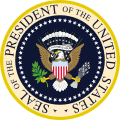 Cleveland delivering his second inaugural address | |
| Date | March 4, 1893 |
|---|---|
| Location | United States Capitol, Washington, D.C. |
| Participants | Grover Cleveland 24th president of the United States — Assuming office Melville Fuller Chief Justice of the United States — Administering oath Adlai Stevenson I 23rd vice president of the United States — Assuming office Levi P. Morton 22nd vice president of the United States — Administering oath |
| ||
|---|---|---|
Personal 28th Governor of New York 22nd & 24th President of the United States
Tenure Presidential campaigns Legacy
 | ||
The inauguration of Grover Cleveland as the 24th president of the United States [1] took place on Saturday, March 4, 1893, [2] at the East Portico of the United States Capitol in Washington, D.C. This was the 27th inauguration and marked the commencement of the second and final four-year term of Grover Cleveland as president and the only term of Adlai Stevenson I [2] as vice president. Cleveland had been inaugurated as the 22nd president exactly eight years earlier, making him the first former U.S. president to be re-inaugurated. Chief Justice Melville Fuller administered the presidential oath of office. It snowed during the inauguration.
